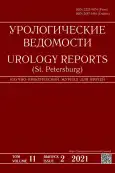Varicocele and its effect on fertility
- Authors: Zamyatnin S.A.1,2, Gonchar I.S.3, Schmidt A.A.3
-
Affiliations:
- Military Medical Academy named after S.M. Kirov, Saint Petersburg
- Priozersk interdistrict hospital
- Military Medical Academy named after S.M. Kirov
- Issue: Vol 11, No 2 (2021)
- Pages: 105-112
- Section: Original articles
- URL: https://journals.rcsi.science/uroved/article/view/34863
- DOI: https://doi.org/10.17816/uroved34863
- ID: 34863
Cite item
Abstract
Varicocele is recognized as one of the most common urological diseases, but its true prevalence is a matter of debate. In the present study, during a screening examination of 442 young men (mean age 21.6 years), grade I varicocele was detected in 7.2%, grade II – in 42.1%, and grade III – in 15.2% of men, varicocele was absent only in 35.5% of men. In 41% of cases, varicocele was diagnosed in isolation on the left side, in 36.5% of cases, bilateral varicocele was detected, and in 22.5%, varicose veins of the spermatic cord were detected on the right. Pathozoospermia was found in 47.3% of patients with grade II varicocele and 61.2% with grade III varicocele. The data obtained in the course of the study showed a significant effect of varicocele and its duration on sperm quality, in particular, on sperm morphology.
Keywords
Full Text
##article.viewOnOriginalSite##About the authors
Sergey A. Zamyatnin
Military Medical Academy named after S.M. Kirov, Saint Petersburg; Priozersk interdistrict hospital
Author for correspondence.
Email: elysium2000@mail.ru
SPIN-code: 7024-0062
Doctor of Medical Sciences, Urologist. Department of Obstetrics and Gynecology, Chief physician
Russian Federation, 6 Academician Lebedev str., Saint Petersburg, 194044; 35, st. Kalinina, Priozersk, Leningrad region, 188760Irina S. Gonchar
Military Medical Academy named after S.M. Kirov
Email: bonechka@mail.ru
SPIN-code: 2768-7253
Candidate of Medical Science, Assistant of the Department of Obstetrics and Gynecology
Russian Federation, 6 Academician Lebedev str., Saint Petersburg, 194044Andrey A. Schmidt
Military Medical Academy named after S.M. Kirov
Email: ShmidtAA@mail.ru
SPIN-code: 4272-5069
Dr. Sci. (Med.), Professor, Head of the Department and Clinic of Obstetrics and Gynecology, Chief Gynecologist of the Ministry of Defense of the RF
Russian Federation, 6 Academician Lebedev str., Saint Petersburg, 194044References
- Agarwal A, Sharma R, Durairajanayagam D, et al. Major protein alterations in spermatozoa from infertile men with unilateral varicocele. Reprod Biol Endocrinol. 2015;13:8. doi: 10.1186/s12958-015-0007-2
- Panner Selvam MK, Agarwal A, Baskaran S. Proteomic analysis of seminal plasma from bilateral varicocele patients indicates an oxidative state and increased inflammatory response. Asian J Androl. 2019;21(6):544–550. doi: 10.4103/aja.aja_121_18
- Alyaev YuG, Glybochko PV, Pushkar’ DYu. Urologiya. Rossiiskie klinicheskie rekomendatsii. Moscow: GEOTAR-Media. 2016. 496 p. (In Russ.)
- Madykin YY, Zolotuhin OV. Varicocele and fertility disorders. Journal of New Medical Technologies. 2013;(2):269–270. (In Russ.)
- Shmidt АА, Zamyatnin SA, Gonchar IS, Korovin AE. Risk factors of the development of male infertiality. Clinical Pathophysiology. 2019;(4):41–45. (In Russ.)
- Shcheplev PA, Apolikhin OI. Muzhskoe besplodie. Obsuzhdenie konsensusa. Bulletin of Reproductive Health. 2010;(3–4):37–44. (In Russ.) doi: 10.14341/brh20103-437-44
- Majzoub A, Esteves SC, Gosálvez J, Agarwal A. Specialized sperm function tests in varicocele and the future of andrology laboratory. Asian J Androl. 2016;18(2):205–212. doi: 10.4103/1008-682X.172642
- Tanrikut C, Goldstein M. Varicocele repair for treatment of androgen deficiency. Curr Opin Urol. 2010;20(6):500–502. doi: 10.1097/MOU.0b013e32833f1b5e
- Artykov KP, Khuseynzoda D, Yuldoshov MA, Khvan IN. Actual problems of varicocele in adolescents. Avicenna Bulletin. 2020;22(2): 286–295. (In Russ.) doi: 10.25005/2074-0581-2020-22-2-286-295
- Pfeiffer D, Berger J, Schoop C, Tauber R. A Doppler-based study on the prevalence of varicocele in German children and adolescents. Andrologia. 2006;38(1):13–19. doi: 10.1111/j.1439-0272.2006.00680.x
- Gurevich AI, Menovshchikova LB, Petrukhina YuV, et al. Varikotsele u detei. Vsegda li nuzhno operirovat’? Pediatric and adolescent reproductive health. 2016;(2):66. (In Russ.)
- Gat Y, Bachar GN, Zukerman Z, et al. Varicocele: a bilateral disease. Fertil Steril. 2004;81(2):424–429. doi: 10.1016/j.fertnstert.2003.08.010
- Povoroznyuk MV. Varicocele as a cause of fertility dysfunction in men in sterile marriage. Reproductive health. Eastern Europe. 2014;5(35):139–146. (In Russ.)
- Osadchuk LV, Popova AV, Voroshilova NA. Infuence of prostatitis and varicocele on reproductive function of young men. Experimental and clinical urology. 2014;(2):77–81. (In Russ.)
- Chiba K, Ramasamy R, Lamb DJ, Lipshultz LI. The varicocele: diagnostic dilemmas, therapeutic challenges and future perspectives. Asian J Androl. 2016;18(2):276–281. doi: 10.4103/1008-682X.167724
- Tsukanov AJ, Semikina SP, Mustafayev RF. Varicocele as a manifestation of connective tissue dysplasia. Urologicheskie vedomosti. 2019;9(2):11–16. (In Russ.) doi: 10.17816/uroved9211-16
- Kapto AA. Endovascular surgery of the iliac veins with bilateral varicocele and varicose veins of the pelvic organs in men. Urologicheskie vedomosti. 2018;8(1):11–17. (In Russ.) doi: 10.17816/uroved8111-17
- Andreeva MV, Khayat SSh, Sorokina TM, et al. Types of pathozoospermia in men with infertility in marriage аnd/or disorders of reproductive system. Andrology and Genital Surgery. 2017;18(2): 33–38. (In Russ.) doi: 10.17650/2070-9781-2017-18-1-62-69
- Meshcheryakov YuV, Nikolaeva AS. Patofiziologicheskii puti razvitiya varikotsele-assotsiirovannogo besplodiya. Novoe slovo v nauke i praktike: gipotezy i aprobatsiya rezul’tatov issledovanii. 2016;(22):37–46. (In Russ.).
Supplementary files








